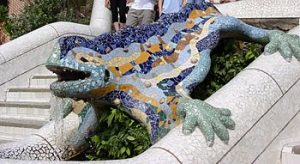After the one-on-one tutorial with Jonathan I was left with plenty of food for thought. One of the ideas that sprung up was that of using trivial, everyday objects to illustrate a deeper narrative. I was inspired by Katherine Mansfield’s writing, where she uses mundane situations and objects to describe a character’s complex thought process. And Jonathan pointed out multiple artists who do the same, for example Jane Wildgoose who has an entire library of objects. Ultimately, it led me to create this piece:

When I discussed this piece in the last group critique of the term, Steph said it reminded her of “Gaudi’s architecture in Barcelona”. Ever since then I’ve been reading and researching bits and pieces of Gaudi’s life and work, searching for inspiration within them.
Over his lifetime Gaudi created the most fantastical architecture. I guess what makes him especially memorable is that he created these gothic buildings that no one else had thought to. Two of his works really stood out to me:


-
Casa Batllo: They called this building the “House of Bones” because of its unusual, skeletal structure. Even the balconies looked like faceless masquerade masks. It essentially looks like something out of a storybook. What is most interesting to me, though, is the patchwork of glass tiles covering the front and roof of the building lending it a vibrancy that makes the building impossible to overlook.
-
Parc Guell: This is a whole park designed by Gaudi, with the same signature, undulating architecture. Again, what stood out to me was the vibrant, assorted use of tile work.
“Trencadis” is the term they used to describe this patchwork art done by Gaudi using broken tiles. I found that this is a type of art very common in Jeddah, adorning sidewalks, restaurants and even crossroads. What initially inspired me about mosaic art was the way it caught sunlight, turning even the most mundane sculptures into something magical and glimmering. That, and the fact that the colorful tiles put together didn’t have to be creating a wonderful picture to look wonderful; even the most abstract of images looked eye-catching.
So I went on a further search to learn more about this “Trencadis” because that is what interested me most about Gaudi’s work. I stumbled across the name Raymond Isidore, and that is when I knew I had struck gold.
Isidore became an artist almost by accident, which is of course the best kind of artist because they are working under true inspiration. He found some pieces of broken glass and crockery and, mesmerized by their multifaceted glimmering, took them home. He then spent the next 30 years turning his one-storey home into a magnificent work of mosaic art people took to calling “La Maison Picassiette”–The House of Million Pieces. How absolutely gorgeous is that!
Isidore and Gaudi’s work left me thinking for several days. There was so much depth and information here that, while it inspired me, I found it difficult to clearly reflect on WHY it did so, or WHAT connection it could have to my own work. And then I realized that it was not just the fascination with Trencadis that connected us; Isidore and Gaudi were a story in and of themselves.
Isidore, the humble sweeper who created this extraordinary and stunningly unique piece of art, scavenging objects from garbage dumps to do so, that is still visited by people all over the world. He spent 30 years of his life creating just this one work, and that work defined the foundation of who he is. He was the narrative hidden in his artwork. And Gaudi, the fine, unusual and sought-after architect who created these strange buildings and yet died of neglect because he was mistaken as a beggar after being hit by a tram.
Further reflections were more concrete; i.e. what does Gaudi and Isidore’s artwork spur me to do?
-
I feel ever more determined to outline a proposal for my initial idea of a community art project where I use upcycled material as tesserae for artwork. It would be even more amazing if, similar to Isidore’s project, this mosaic could be turned into a landmark for Karachi. A commentary on Karachi to stand the test of time.
-
I want explore basic sculpting and covering those sculptures with tesserae similar to the pieces in Parc Guell, and similar to the kind of art that surrounds me in Jeddah.


